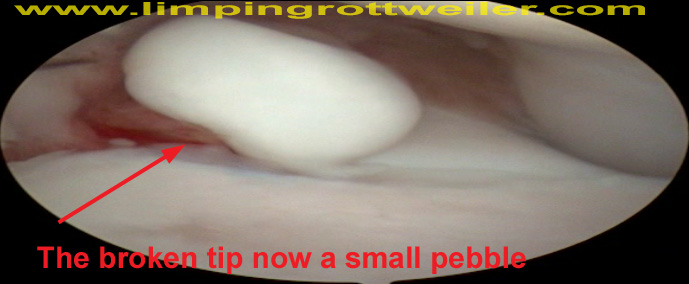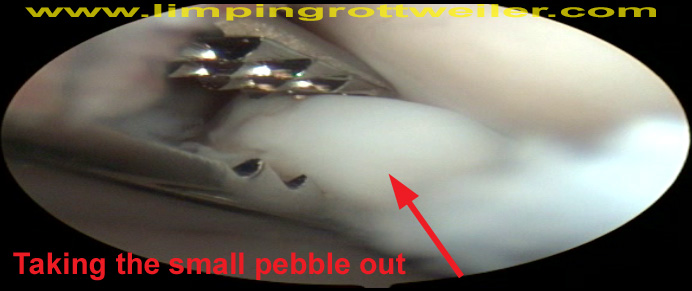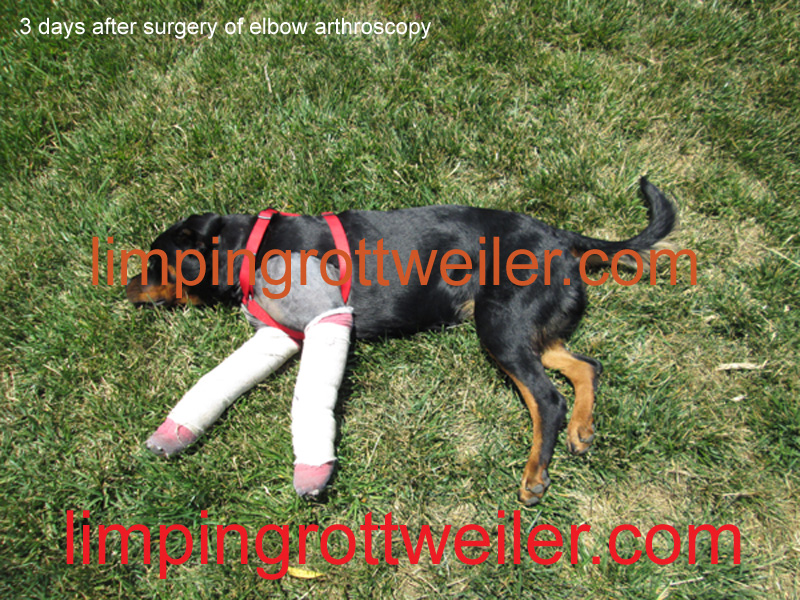

| HOME | My Story | Diagnosis | Treatment | Conclusion | About |
Treatment and Recovery of Elbow Dysplasia (FCP) in Rottweiler Puppies
With Arthroscopy Surgery
Redwood's Krest's Basra AKC# WS41855004
Finding a good orthopedic surgeon in short notice wasn't a simple task. I had to call all over the west coast and as far as Colorado. I was looking for a knowledgeable surgeon in this specific procedure (Elbow Arthroscopy and Ulnar Osteotomy), that could give me a phone consultation to tell me what could be done based on the (super expensive) $1200 CT scan I already had without driving several hours to his clinic. I found only two, one in the Los Angeles area and one in Colorado, and we chose the surgeon in Los Angeles (Tustin, CA).
Based on my research, prices for performing only the bilateral surgery ranged from $2900 to $7800 in Marine county, San Francisco, regardless of knowledge and service.
A cost for CT scan for both sides with consultation can range from $550 to $1200 (I didn't have time learning I can save on the CT scan high cost).
A cost for x-ray for both
sides with consultation can range from $400 to $600
MRI will show even more information than an x-ray or CT, but is limited because of the expense and availability.
Early treatment is important
for this problem, and if you read My
Story, you will see how easy it is to misunderstand the puppy’s
early symptoms or receive misinformation in the early stages. The first signs of
limping of my puppy came at 5 and 1/2 months, and a bilateral elbow arthroscopy
surgery with Biceps Ulnar release (BURP) was done only at age of 10 and 1/2 months. No
Ulnar Osteotomy performed.
Below are videos of the
procedures that occurred on both legs of my puppy:
|
Right elbow arthroscopy surgery
|
The right leg had the bad limping,
which is also the weaker looking leg.
The bad limping was mostly on the right leg and it was showing only because the tip of the Coronoid Process of the Ulna broke and got trapped in the joint. In the video, it is the small pebble that you see being removed. It is all round because of all the grinding from walking with it inside the joint. |
| Right elbow
|
Right elbow
|
|
Left elbow arthroscopy surgery
|
The left leg was looking much better, it did not show any
significant limping which never lasted more than a few seconds and was fairly strong.
(letting you think the puppy just made a wrong move) However this joint also suffered because of all the bone particles floating around from the broken
Coronoid.
|
| Left elbow
|
Left elbow
|
Importance of Early Diagnosis and the Recovery Stages After Surgery
Long before the limping
started, I notice some kind of discomfort in my puppy at around 4 to 5 months.
If the puppy is with you 24/7 like mine was with me, you should be able to
notice some silent crying (whimpering) from discomfort. (Remember that a puppy
at this age will make his best effort to hide this weakness from his leader). But
who knew back then what these subtle symptoms really meant…
At this early stage even
before the tip of the Ulna bone (Coronoid process) is broken, when the puppy is
at a sitting position, because of the discomfort, the puppy will move or growl
when someone is trying to reach for this area or touch the shoulder area (he may
not do this with the owner or leader).
Theoretically, at this age
before the bone is broken, if you could put the puppy in a crate, resting him
all the time up to the age of 18 months, you could reduce the severity of the
disability. In recent years there are some initial studies for some
procedures that can help to relieve pressure off the Ulna that will increase the
chance for better recovery. (See References - Biceps ulnar release (BURP).
Once the bone has the fracture
or a total broken part of the Coronoid Process of the Ulna, the grinding and
rapid wearing of the cartilage begins! So, if you understand this part, then it
is most logical to start the treatment as soon as possible, because the
cartilage will not heal itself so well where the grinding has occurred.
Right after the surgery the
heavy limping completely disappeared due to the removal of the
"pebble" and the complete rest. The surgery included; Bilateral elbow
arthroscopy with fragment removal and ulnar biceps tendon release (BURP). (It
did not include any bone cutting as Ulnar Osteotomy).

As time progressed, bandages
were removed on the 6th day and sutures at 14 days. We were then able to go on
some short walks on a leash. At this point both legs seemed to be the same, no
limping detected, except for the first few steps right after rising from lying
down. I also noticed she was willing to bear more weight on the bad right leg.
One other sign you should
watch for is a large bulging at the side of both elbows, due to an increased
amount of joint fluid (swelling of the joint capsule).
At 6 weeks the rest
restriction was over and we increased activity with longer leash walks, but very
gradually, with no running or jumping. The bulging (swelling) was the same
and limping was noticeable only right after getting up for a few warm up steps
(a few times we did have a few more steps of limping).
At 7 weeks, I already noticed
that the left leg (which was the better leg without the pebble), showed much
better recovery. It could be seen that the swelling decreased by about 50
percent on the left, and on the right I could not notice much reduction in the
swelling.
At 8 weeks we were able to go
swimming once or twice a week and we hope we can build some muscles. Other
than the training difficulty due to the rest restriction, there are a few other
problems in starting activity after long rest.
One of them is Cold
Tail, Dead Tail, Limber Tail.
At 9 weeks after the surgery,
we increased the walks up to a good 50 minutes at a fast walking pace, without
having any increase in stiffness or lameness after resting. The swelling of the
elbow joint capsule hasn't increased either. However, we would like to see
the swelling decrease even further. At every stage of this recovery, I can
see how bad it was delaying treatment. The left leg has done better than the
right leg, and has shown much better progress in this recovery, just because it
had less of the wear and tear inside the elbow joint.
At 10 weeks after the surgery,
clinical signs are
the same with no change. I feel we reached some barrier. it is the maximum activity we can safely
have and we need more time.
(max of 60 minutes walk 2 x day. Do not encourage running or jumping. Not much of downhill walk because of the risk of the dog running downhill, out of control). we try to substitute walks with swimming once or twice a week.
At 4 months after the surgery, we continue with the same as above, one hour walk twice a day. Her walk and gait became much tighter firm and solid and nicer. No lameness even after occasional running and resting. Except, that around this time, we had two incidents of bad limping that lasted less than a day. We treated this with complete rest and pain medication on first sign of limping.
At 4 1/2 months after the surgery, you really feel how the dog pushing for more running and you have to keep the self-control, not to forget you have a sick dog. although we had some occasional running and even short dog play, there were no sign of limping.
At 5 months after the surgery, the puppy is doing fine, but I begin to understand what is a "Pet". It looks like the best that it will be, is a crippled "Pet".
At 6 months after the surgery - the dog has an okay muscle build up and is very motivated to run and be active. Seems to be feeling very good.
At 7 months after the surgery or 1&1/2 of age - dog is feeling good. However, because of the bad leg deformity, we do not encourage much of running and definitely not any rough and crazy running or jumping.
|
Slow Motion Walking
|
Rottweiler with Elbow Dysplasia. Redwood's Krest's AKC# WS41855004 |
One year after the surgery or 1 year and 10 months of age - dog is very fit and strong from all the walking and swimming. However, any hard impact (jumping) on front legs will cause a funny gait and even bad limping. We also had some incidents which the dog stumbled on the front leg, which caused some heavy limping for a few days.
At 1 year and 11 months there are times that light to heavy limping occurs at irregular intervals.
At 2 years and 2 months the bulging at the elbow is smaller than ever. The dog walks very nicely and doesn't limp at all, even after resting. This is despite the fact that we had a few more than normal (unintended) incidents of too vigorous jerks and runs. However, the lameness sometimes returns without notice -- even from light, simple activity -- and it only takes a small wrong move by the dog.
It seems that due to all this condition and the surgery, there is some balance deficit and weakness of the elbow joint and as a result, the dog is experiencing what seem to be elbow sprains – much the same as we experience ankle sprains. Due to the weak and unbalanced joint, they experience the sprains very frequently and from any minor stress. I think this is very important to understand so you can be aware of the issue and immediately make sure the dog is constrained to only walk on flat ground so there is no extra stress on the elbow -- just as we do when we have an ankle sprain.
At 2 years and 11 months. We have not experienced any limping for the past 8 months.
At 3 years, 2 months. Mild limping that lasted about 3 weeks. which makes it 11 months with no limping.
At 3 years, 8 months. No limping in the past 5 months. (we never encourage any jumping or running).
At 4 years, 9 months. No limping. Daily walk of 45 minutes to an hour. Dog is strong with good muscle build up. (we never encourage any jumping or running). Keep them very lean. less weight is better.
We made it to 7 years. At 7 years, No limping. Once daily walk of 45 minutes to an hour. Reduce activity with any noticeable weakness or funny gait.
At age of 7 and 8 years old around summer time, we had some life threatening seizure episodes which turned out to be from digestion of Poison Hemlock or from use of some Generic Frontline Plus which contains Fipronil and or Methoprene.
We are almost 9 years old (8 years, 10 months). No limping. BUT, the daily walk was reduced to only weekdays for an easy walk under 45 minutes.
We are at 9 years, 10 months. I think we got control on the seizures which most likely came from the Poison Hemlock which grows widely all over the bay area California or the Generic Frontline Plus which contains Fipronil and or Methoprene. We reduced the daily walk to less than 30 minutes.
At age of 10 years, 4 months. We use CBD (THC Free) and it seems to reduce the seizures. walks are short under 20min. (but we also eliminate the Poison Hemlock and the Generic Frontline Plus which contains Fipronil and or Methoprene.
At age of 10 years, 10 months and 25 days. On June, 17, 2023 We had to say goodbye. A very aggressive Osteosarcoma which spread across the front leg (Radius) bone in about two months.
|
Dietary Supplements (Kirkland Costco): High dose: Low dose: Split the daily dose to morning and evening.
|
|
I believe
if I was told early enough
my puppy most likely will develop ED or was at a higher risk than most
Rottweilers, at least I could have provided early treatment and could have
reduced the pain and suffering with much better outcome.
| HOME | Contact: [email protected] |